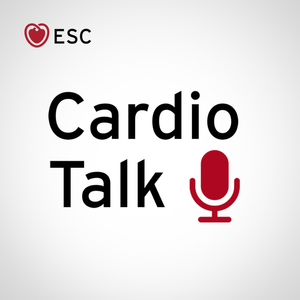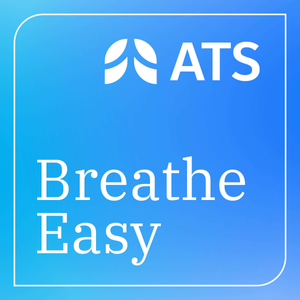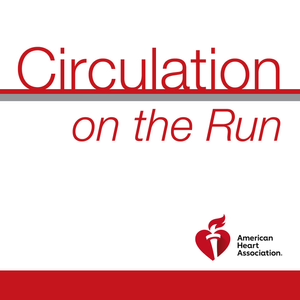
Circulation September 6, 2022 Issue
09/05/22 • 24 min
This week, please join author Keith Channon as he discusses the article "Risk of Myocarditis After Sequential Doses of COVID-19 Vaccine and SARS-CoV-2 Infection by Age and Sex."
Dr. Carolyn Lam:
Welcome to Circulation on the Run, your weekly podcast summary and backstage pass to the journal and its editors. We're your co-hosts, I'm Dr. Carolyn Lam, associate editor from the National Heart Center and Duke-National University of Singapore.
Dr. Greg Hundley:
And I'm Dr. Greg Hundley, associate editor, director of the Pauley Heart Center at VCU Health in Richmond, Virginia.
Dr. Carolyn Lam:
Oh, Greg, today's feature paper, something that's really been discussed a lot in the press and in lay public as well, the risk of myocarditis following sequential doses of the COVID-19 vaccine and SARS-CoV-2 infection by age and sex. Everyone's going to want to tune into that one. But before we get there, shall we go through some of the key papers in today's issue?
Dr. Greg Hundley:
You bet, Carolyn. How about if I go first?
Dr. Carolyn Lam:
Please.
Dr. Greg Hundley:
So Carolyn, this first manuscript involves the world of machine learning and ECG interpretation. And as you know, novel targeted treatments increase the need for prompt hypertrophic cardiomyopathy detection; however, it's low prevalence, 0.5%, and resemblance to common diseases really present challenges. So Carolyn, these authors, led by Dr. Rahul Deo from Brigham and Women's Hospital, sought to develop machine learning models to detect hypertrophic cardiomyopathy and differentiate it from other cardiac conditions using EKGs and echocardiograms with a robust generalizability across multiple cohorts.
So Carolyn, what did they do? They used single-institution hypertrophic cardiomyopathy EKG models that were then trained and validated on data from three academic medical centers in the United States and Japan using a federated learning approach, which enables training on distributed data without data sharing. Models were validated on held out test sets for each institution and from a fourth academic medical center and were further evaluated for discrimination of hypertrophic cardiomyopathy from aortic stenosis, long-standing hypertension, and cardiac amyloidosis. And then finally, automated detection was compared to manual interpretation by three cardiologists on a data set with a realistic hypertrophic cardiomyopathy prevalence.
Dr. Carolyn Lam:
Wow, incredible. So what were the results?
Dr. Greg Hundley:
Right, Carolyn. So the authors identified 74,476 EKGs for 56,129 patients and 8,392 echocardiograms for 6,825 patients across the four academic medical centers. Now, while ECG models trained on data from each institution displayed excellent discrimination of hypertrophic cardiomyopathy on internal test data, the generalizability was limited, most notably for a model trained in Japan and then subsequently tested in the United States. Now, however, when trained in a federated manner, discrimination of hypertrophic cardiomyopathy was excellent across all institutions, including for phenotypic subgroups. The models further discriminated hypertrophic cardiomyopathy from hypertension, aortic stenosis, and cardiac amyloid. Analysis of ECG and echocardiography paired data from 11,823 patients from an external institution indicated a higher sensitivity of automated HCM detection at a given positive predictive value compared with cardiologists.
So Carolyn, in conclusion, federated learning improved the generalizability of models that use EKGs and echocardiograms to detect and differentiate hypertrophic cardiomyopathy from other causes of left ventricular hypertrophy compared to training within a single institution. It will be really interesting to see the future applicability of these methods.
Dr. Carolyn Lam:
Oh, I'm such a fan of this work. Awesome. Thank you, Greg. My paper, it's a preclinical paper that uncovers a novel mechanism through which GATA4 mutations can lead to heart disease.
Dr. Greg Hundley:
All right, Carolyn, no quiz this time, I'm just coming right out. I'm reversing the question on the teacher. Tell me, what is GATA4?
Dr. Carolyn Lam:
I'm glad you asked, Greg. GATA4 is a zinc finger-containing DNA binding transcription factor essential for normal cardiac development and homeostasis in mice and humans, and mutations in this gene have been reported in human heart defects. Now, in today's paper, authors led by Dr. Srivastava from Gladstone Institutes in San Francisco, California, showed that GATA4 regulated cell-type-specific splicing through direct interaction with RNA and the spliceosome in human-induced pluripotent stem cell-derived cardiac progenitors.
An unbiased search for GATA4 interacting proteins in these human iPS cells revealed interaction with many members of the sp...
This week, please join author Keith Channon as he discusses the article "Risk of Myocarditis After Sequential Doses of COVID-19 Vaccine and SARS-CoV-2 Infection by Age and Sex."
Dr. Carolyn Lam:
Welcome to Circulation on the Run, your weekly podcast summary and backstage pass to the journal and its editors. We're your co-hosts, I'm Dr. Carolyn Lam, associate editor from the National Heart Center and Duke-National University of Singapore.
Dr. Greg Hundley:
And I'm Dr. Greg Hundley, associate editor, director of the Pauley Heart Center at VCU Health in Richmond, Virginia.
Dr. Carolyn Lam:
Oh, Greg, today's feature paper, something that's really been discussed a lot in the press and in lay public as well, the risk of myocarditis following sequential doses of the COVID-19 vaccine and SARS-CoV-2 infection by age and sex. Everyone's going to want to tune into that one. But before we get there, shall we go through some of the key papers in today's issue?
Dr. Greg Hundley:
You bet, Carolyn. How about if I go first?
Dr. Carolyn Lam:
Please.
Dr. Greg Hundley:
So Carolyn, this first manuscript involves the world of machine learning and ECG interpretation. And as you know, novel targeted treatments increase the need for prompt hypertrophic cardiomyopathy detection; however, it's low prevalence, 0.5%, and resemblance to common diseases really present challenges. So Carolyn, these authors, led by Dr. Rahul Deo from Brigham and Women's Hospital, sought to develop machine learning models to detect hypertrophic cardiomyopathy and differentiate it from other cardiac conditions using EKGs and echocardiograms with a robust generalizability across multiple cohorts.
So Carolyn, what did they do? They used single-institution hypertrophic cardiomyopathy EKG models that were then trained and validated on data from three academic medical centers in the United States and Japan using a federated learning approach, which enables training on distributed data without data sharing. Models were validated on held out test sets for each institution and from a fourth academic medical center and were further evaluated for discrimination of hypertrophic cardiomyopathy from aortic stenosis, long-standing hypertension, and cardiac amyloidosis. And then finally, automated detection was compared to manual interpretation by three cardiologists on a data set with a realistic hypertrophic cardiomyopathy prevalence.
Dr. Carolyn Lam:
Wow, incredible. So what were the results?
Dr. Greg Hundley:
Right, Carolyn. So the authors identified 74,476 EKGs for 56,129 patients and 8,392 echocardiograms for 6,825 patients across the four academic medical centers. Now, while ECG models trained on data from each institution displayed excellent discrimination of hypertrophic cardiomyopathy on internal test data, the generalizability was limited, most notably for a model trained in Japan and then subsequently tested in the United States. Now, however, when trained in a federated manner, discrimination of hypertrophic cardiomyopathy was excellent across all institutions, including for phenotypic subgroups. The models further discriminated hypertrophic cardiomyopathy from hypertension, aortic stenosis, and cardiac amyloid. Analysis of ECG and echocardiography paired data from 11,823 patients from an external institution indicated a higher sensitivity of automated HCM detection at a given positive predictive value compared with cardiologists.
So Carolyn, in conclusion, federated learning improved the generalizability of models that use EKGs and echocardiograms to detect and differentiate hypertrophic cardiomyopathy from other causes of left ventricular hypertrophy compared to training within a single institution. It will be really interesting to see the future applicability of these methods.
Dr. Carolyn Lam:
Oh, I'm such a fan of this work. Awesome. Thank you, Greg. My paper, it's a preclinical paper that uncovers a novel mechanism through which GATA4 mutations can lead to heart disease.
Dr. Greg Hundley:
All right, Carolyn, no quiz this time, I'm just coming right out. I'm reversing the question on the teacher. Tell me, what is GATA4?
Dr. Carolyn Lam:
I'm glad you asked, Greg. GATA4 is a zinc finger-containing DNA binding transcription factor essential for normal cardiac development and homeostasis in mice and humans, and mutations in this gene have been reported in human heart defects. Now, in today's paper, authors led by Dr. Srivastava from Gladstone Institutes in San Francisco, California, showed that GATA4 regulated cell-type-specific splicing through direct interaction with RNA and the spliceosome in human-induced pluripotent stem cell-derived cardiac progenitors.
An unbiased search for GATA4 interacting proteins in these human iPS cells revealed interaction with many members of the sp...
Previous Episode
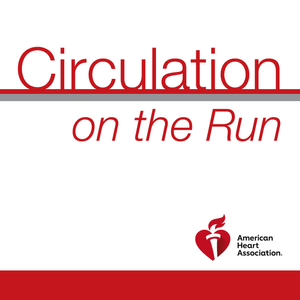
Circulation August 30, 2022 Issue
This week, please join author Rod Stables and Associate Editor Nick Mills as they discuss the article "Routine Pressure Wire Assessment Versus Conventional Angiography in the Management of Patients With Coronary Artery Disease: The RIPCORD 2 Trial."
Dr. Carolyn Lam:
Welcome to Circulation on the Run, your weekly podcast, summary and backstage pass through the journal and its editors. We're your co-hosts! I'm Dr. Carolyn Lam, associate editor from the National Heart Center and Duke National University of Singapore.
Dr. Greg Hundley:
And I'm Dr. Greg Hundley, Associate Editor, Director of the Pauley Heart Center at VCU Health in Richmond, Virginia.
Well, Carolyn, this week's feature... Very interesting. There is a lot of information about using fractional flow reserve during contrast coronary angiography. But how does that compare to just reviewing the angiograms when managing patients with coronary artery disease?
Well, we are going to hear some results from the RIPCORD 2 trial, and they may surprise you a little bit. But, before we get to that interesting feature discussion with authors and editors, how about we grab a cup of coffee and dive into some of the other articles in the issue?
Dr. Carolyn Lam:
Yeah, let's do that, Greg. Do you have a paper to share first?
Dr. Greg Hundley:
Oh, thanks Carolyn. Sure.
So Carolyn, as we know, Apolipoprotein B or apoB, provides an integrated measure of atherogenic risk. But whether apoB levels and apoB lowering hold incremental predictive information on residual risk after acute coronary syndromes, beyond that provided by low density, lipoprotein cholesterol, or LDLC, that's uncertain. So Carolyn this study emanates from the Odyssey Outcomes trial, which compared the Proprotein Convertase Subtilisin/Kexin Type 9 inhibitor, Evolocumab with placebo in 18,924 patients with recent ACS and elevated atherogenic lipoproteins despite optimized statin therapy. Now the primary outcome was major adverse cardiovascular events. So MACE was coronary heart disease, death, nonfatal myocardial infarction, fatal non-fatal ischemic stroke, and hospitalization for unstable angina. And associations between baseline ApoB or ApoB at four months and MACE were assessed in adjusted Cox proportional hazards and propensity score matched models over median of 2.8 years.
Dr. Carolyn Lam:
Oh, right. So what were the results, Greg?
Dr. Greg Hundley:
Right, Carolyn so impatience with recent ACS and elevated atherogenic lipoproteins, MACE increased across baseline ApoB strata, and now evolocumab reduced MACE across all strata of baseline ApoB, with larger absolute reductions in patients with higher baseline levels. Lower achieved ApoB was associated with lower risk of MACE, even after accounting for achieved LDLC or Non-HDLC indicating that ApoB provides incremental information. And therefore, Carolyn, if it is modified achievement of an ApoB level less than or equal to 35 milligrams per deciliter may reduce lipoprotein attributable residual risk after ACS. Isn't that interesting?
Dr. Carolyn Lam:
Yes. Very nice, Greg. Thank you. This next paper is a pre-specified analysis of the EMPEROR-Preserved trial, looking at patients with and without diabetes.
Dr. Greg Hundley:
So remind us, Carolyn, what was the EMPEROR-Preserved trial and what did it show?
Dr. Carolyn Lam:
Well, in EMPEROR-Preserved Empagliflozin, the SGLT2 inhibitor reduced risk of the composite of cardiovascular death or heart failure hospitalization, as well as first and recurrent heart failure hospitalizations and slowed renal function decline in patients with heart failure and an ejection fraction greater than 40%. So the current paper sought to determine if effects were consistent in patients with, and without diabetes, of the almost 6,000 patients enrolled, 49% had diabetes. The risk of adverse outcomes, first of all, was higher in patients with diabetes. Now the treatment effect of Empagliflozin was however, similar in that Empagliflozin reduced the rate of the primary outcome and total heart failure hospitalization, irrespective of diabetes status. The effect of Empagliflozen falls into attenuate GFR decline, however, was also present in patients with, and without diabetes, although more pronounced in patients with diabetes. Now across all these three endpoints, the effect of Empagliflozen did not differ in patients with prediabetes or normal glycemia. And importantly, there was no increased risk of hypoglycemic events in either subgroup compared with placebo. So a very nice paper there. And that was from Dr. Gerasimos Filippatos from Athens University Hospital Attikon and colleagues.
Dr. Greg Hundley:
Wow, Carolyn, just really interesting information coming out of the world of SGLT2 innovation. Well, Carolyn, my next paper comes to us from the world of preclinical sci...
Next Episode
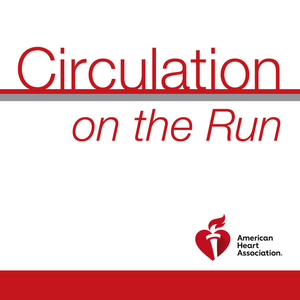
Circulation September 13, 2022 Issue
This week, please join authors Svati Shah and Senthil Selvaraj as well as Guest Editor and Editorialist Manuel Mayr as they discuss the article "Metabolomic Profiling of the Effects of Dapagliflozin in Heart Failure With Reduced Ejection Fraction: DEFINE-HF" and the editorial "SGLT2 Inhibitors in Heart Failure: Targeted Metabolomics and Energetic Metabolism."
Dr. Carolyn Lam:
Welcome to Circulation On Run, your weekly podcast summary and backstage pass to the journal and its editors. We're your co-hosts, I'm Dr. Carolyn Lam, Associate Editor from the National Heart Center and Duke National University of Singapore.
Dr. Greg Hundley:
And I'm Dr. Greg Hundley, Associate Editor, Director of the Pauley Heart Center at VCU Health Richmond, Virginia.
Dr. Carolyn Lam:
In today's feature paper, we will be talking about the metabolomic profiling of the effects of dapagliflozin in heart failure, and this is from the DEFINE-HF trial. It's just such a cool paper with a lot of insights you have to hear from the authors. But, before we get there, let's talk about some of the other papers in today's issue. Shall we, Greg?
Dr. Greg Hundley:
You bet, Carolyn. Well, how about if I go first?
Dr. Carolyn Lam:
Please.
Dr. Greg Hundley:
Thank you, Carolyn. My first paper comes to us from Professor Paulus Kirchhof from the Universitäres Herzzentrum in Hamburg. Carolyn, in the randomized EAST-AFNET 4 study, so the early treatment of atrial fibrillation for stroke prevention, these trial investigators demonstrated that systematic initiation of early rhythm control reduced adverse cardiovascular outcomes in patients with recently diagnosed atrial fibrillation and stroke risk factors. However, the effectiveness and safety of early rhythm control in patients with multiple cardiovascular comorbidities is not known. Carolyn, in this study, it was a prespecified sub-analysis of the EAST-AFNET 4 trial and it compared the effectiveness and safety of early rhythm control with usual care stratified into patients with high CHA2DS2-VASc scores of greater than or equal to 4.
Dr. Carolyn Lam:
Nice. Okay. Important question, what did they find?
Dr. Greg Hundley:
Right, Carolyn. Quite a bit of data in this study, so let's walk through it carefully. First, in regards to the study population, the EAST-AFNET 4 randomized 1093 patients with CHA2DS2-VASc scores of greater than or equal to 4, these were predominantly women, 61% female, and then also 1,696 patients with CHA2DS2-VASc of less than four, and these were predominantly men, so only 37% women.
Now let's get to the date. Early rhythm control reduced the composite primary efficacy outcome of cardiovascular death, stroke, or hospitalization for worsening heart failure or for acute coronary syndrome in patients with high CHA2DS2-VASc scores of greater than 4, but not in patients with CHA2DS2-VASc scores of less than 4. Second, now Carolyn, the primary safety outcome, so death, stroke, or serious adverse events of rhythm control therapy, was not different between study groups in patients with high CHA2DS2-VASc scores of greater than 4, but occurred more often in patients with low CHA2DS2-VASc scores randomized to early rhythm control. Now Carolyn, life threatening events or death were not different between the groups. When female sex was ignored for the creation of high and lower groups, the interaction P was not significant for the primary efficacy outcome, but remained significant for the primary safety outcome.
Dr. Carolyn Lam:
Oh, you are right. A lot of interesting data here. What's a take home message?
Dr. Greg Hundley:
Right, Carolyn. So the take home message is the following. Patients with recently diagnosed atrial fibrillation and multiple cardiovascular comorbidities should be considered to have priority access to early rhythm control to reduce cardiovascular outcomes, and a specific trial of early rhythm control in these patients is really needed as a next step.
Dr. Carolyn Lam:
Oh, thank you, Greg. The next paper focuses on arrhythmogenic right ventricular cardiomyopathy, which we know is characterized by a high propensity to life threatening arrhythmias and progressive loss of heart muscle. More than 40% of reported genetic variants linked to arrhythmogenic right ventricular cardiomyopathy, or ARVC, reside in a gene called plakophilin-2, or PKP2. In today's paper, Dr. Delmar and Lundby from NYU Grossman School of Medicine and University of Copenhagen, respectively, and their colleagues, described a comprehensive characterization of the ARVC molecular landscape using a multidisciplinary approach including human samples from ARVC patients with PKP2 mutations and left ventricular ejection fraction above 45%, as well as PKP2-deficient murine and human induced pluripotent stem cell-derived cardiomyocytes. They studied all of t...
If you like this episode you’ll love
Episode Comments
Generate a badge
Get a badge for your website that links back to this episode
<a href="https://goodpods.com/podcasts/circulation-on-the-run-255644/circulation-september-6-2022-issue-29730388"> <img src="https://storage.googleapis.com/goodpods-images-bucket/badges/generic-badge-1.svg" alt="listen to circulation september 6, 2022 issue on goodpods" style="width: 225px" /> </a>
Copy

